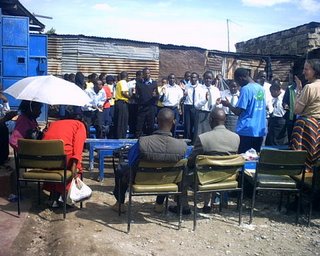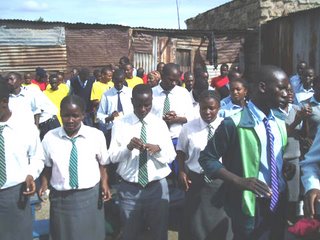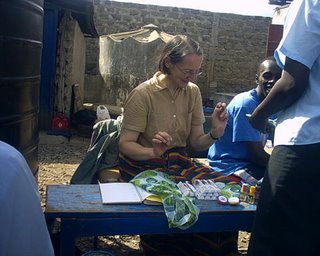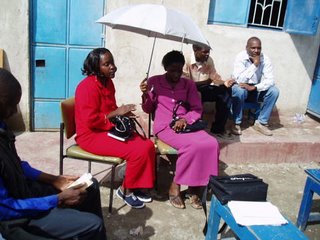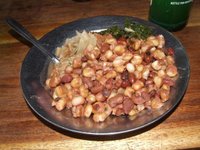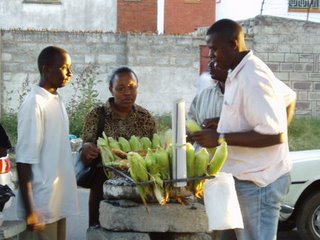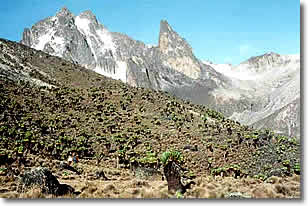:::::::::::::::::::::::::::::::::::::::::::::::::::::::::::::::::::::::::::::::::::::::::::::::::::::
Japan Culture Week in Nairobi 2012
Invitation to the Haiku Clubs of Nairobi
Date: Thursday, 5 April 2012
The members of the Bamboocha and Peacocks Haiku Clubs had been looking forward to the great day with expectation and excitement. Unlike on other occasions, when the haijin had used public transport, this time the school bus was made available for them. It was one of their smoothest and most enjoyable rides from Kayole to Upper Hill, listening to music and sightseeing. The haijin were 78 students and four teachers.
It was a cloudy morning, and it had rained the previous night. This was the first rain signalling the onset of the long rains, which had come a little late this year.
On arrival at the Embassy, we were warmly and courteously welcomed. The security procedure was elaborate and rigorous, as all items were screened and deposited with the security staff. Both the haijin and teachers were amazed at these rigorous security checks. Mobile phones and cameras were not allowed into the Embassy; no photographs in or around the Embassy were allowed. We were only authorised to take photographs in the Embassy Hall.
The first session was a film about Japan, which highlighted the following areas:
-- education,
-- the economy,
-- culture,
-- international co-operation,
-- industry,
-- technology.

Preparing for the film projection
Session two was origami. It was exciting as the students were taught how to make things of different shapes by folding paper. These things ranged from animals to geometrical shapes. It was amazing to learn that it takes four days to construct a horse! After the demonstration, students were each given six papers and asked to make a cube. It was exciting even to the teachers.
I fold paper
the opposite way --
origami
missing one step --
I assemble a wobbly
cube
~ Patrick Wafula

Origami sheets ready
In the third session, the haijin were taught some Japanese greetings, common phrases and the numbers 1 to10. This was followed by an oral quiz to assess which haijin in the hall had been the most attentive. Most as some of the numbers, it turned out, sound like words in the English language. The haijin enjoyed finding those words and matching them with the numbers to enable them to remember the numbers better.
1: ichi (itchy)
2: ni (knee)
3: san (sun / son)
4. shi / yon: (she / yawn)
Session Four was a Japanese Love and Family Relations Film, which was very much enjoyed by all. It was about a young man called Matsuo and a girl called Izumi, and a restless, ever travelling old man called Tora, who had so many women in his life, but none for a wife, until he met Lily, an aged, but beautiful woman from an island. Izumi was in love with Matsuo, but her parents betrothed her to another man because Matsuo was jobless, but in the end, each of these couples were happily married.
dark room --
the projector’s gentle
hum

Film projection
Lastly the haijin were allowed to tour the library and take a number of photos before boarding their bus and heading back to Eastlands. The rest of the experiences are very personal and are only revealed through the haiku and photos that accompany this write up. All the haiku were written within the Embassy.
The haijin are gratefully indebted to Isabelle Prondzynski, our Moderator, for providing the haijin with transport fare, Otinga Andrew, for organizing the St. Mathew haijin, availing the bus and providing administrative support throughout the excursion; the Japanese Embassy staff, Shemi, David and Susan for taking the haijin through all the exciting events above: David san for a very interesting origami session; Susan san for teaching the haijin Japanese greetings and numbers; and Shemi san for organizing the whole event and inviting us. Last, but not least, the entire Embassy of Japan in Nairobi for their six years of co-operation and support to the Haiku Clubs of Nairobi.

School bus waiting for the return journey
:::::::::::::::::::::::::::::::::::::::::::::::::::::::::::::::::::::::::::::::::::::::::::::::::::::
cultural show --
reflected ray from Japanese
aquarium
~ Caxton Okoth
car park --
our bus enters after
a security check
~ Diana Dolla
rush --
the sliproad overloaded
with vehicles
~ Moses Nyawanga
writing haiku --
her head moves with the
grasshopper's hop
~ Flora Mbayi
origami --
colored papers litter
the grey carpet
security check --
a tweet on leaving
the glass cabinet
~ Brian Etole
origami --
I find it exciting making
colored boxes
learning lesson --
I find it hard pronouncing
Japanese words
dark clouds --
I shiver from light showers and
cool breeze
~ Brian Mulando
slippery floor --
I nearly fall but my friend
catches me
~ Winfridah Malesi
dark clouds --
an eagle flies around
the embassy aerial
~Annabel Mwendwa
dark clouds --
raindrops fall on the
happy haijin
~ John Maina
dark room --
I enjoy a Japanese
comic movie
~ Ezekiel Mbira
the end --
the Japanese movie leaves
me in suspense
~ Dennis Wright
haijins' uproar --
three dolphins dance
on water
coloured cubes
on white tables --
origami
folding --
the yellow paper
gets torn
one bulb after
the other turns on --
roaring generator
~ Andrew Otinga

Andrew Otinga and the origami sheets
we go through
the vigorous screening...
Japan Embassy
~ Jackson Shilaho
origami --
I concentrate on making
my colorful box
~ Metrine Okalo
Japanese embassy --
a warm welcome from
the guards
~ Geoffrey Maina
coloured papers --
I struggle to make
a cube
colorful table --
students display their
finished cubes
lights off --
the start of a Japanese
cultural movie
rain drops --
rythmic mabati sound
lulls her to sleep
~ Elijah Juma
Japanese library --
she is attracted to the left
bookshelf
chilly noon --
trees swaying
sideways
~ Marcellina Amunze
upstairs --
he holds a flower
smilingly
~ Joseph Musango
several folds --
a colourful box on
the table
embassy library --
the books arranged
alphabetically
~ Joshua Kaweto
colourful compound--
flowers nourishes the
environment
~ Agness Ndinda
Japanese Embassy --
the Japanese flag sways
in the breeze
~ Mary Wanjama
a bee sucks nectar
from morning glory --
Embassy wall
rain --
morning dew shining
on the grass
~ Sylvia Mmbone
Japan Embassy --
a paved corridor roofed
with climbing plants
Japanese film --
quiet theatre as we watch
a cultural show
~ Isaac Ndirangu
shuffle of papers
as we make cubes --
silent room
~ Stephen Macharia
Japanese Library --
haijin enjoy Japanese
monuments
~ Lucy Mukuhi
jovial faces --
haijin enjoy Japanese
arts
~ Willis Wanga
origami makes
the haijin to think --
calm room
~ Collins Omuganda
noon drizzle --
droplets fall from
a eucalyptus tree
colourful fireworks --
Japanese culture on
display
~ Eric Mwange
jacaranda tree --
leaves sway from side
to side
~ Irene Aluoch
students tour
the Embassy --
short break
~ Felix Kavayo
Embassy --
such a clean
environment
~ Hillaey Shisoka
dolphins swim
and dance happily --
movie
~ Melvine Ayako
dark room --
cheers after watching
the movie
~ Emmanuel Mutati
Japanese poem --
we understand Japanese
movie
~ Koskei Cornelios
students squeeze
through security door --
Embassy exit
~ Consolata Akoth
haijin sit
on the grass to write haiku --
Embassy visit
~ Anonymous
cold weather --
we put on sweaters
outside the Embassy
~ Mary Njambi
haijin struggle
through the security door --
Japanese Embassy
~Victor Obutho
cold morning --
the scent of flowers
at the gate
~ Susan Njeri
flower bed --
a withered rose
falls down
~ Eunice Katiwa
echoing hall --
the haijins’ jubilation
after the movie
flower bed --
an uprooted weed lies
on the pavement
~ Gloria Kerubo
-----------------------
Report and photos by Patrick Wafula for Kenya Saijiki
*****************************
Related words
. Japane Culture Week 2008 .
[ . BACK to WORLDKIGO . TOP . ]
:::::::::::::::::::::::::::::::::::::::::::::::::::::::::::::::::::::::::::::::::::::::::::::::::::::




